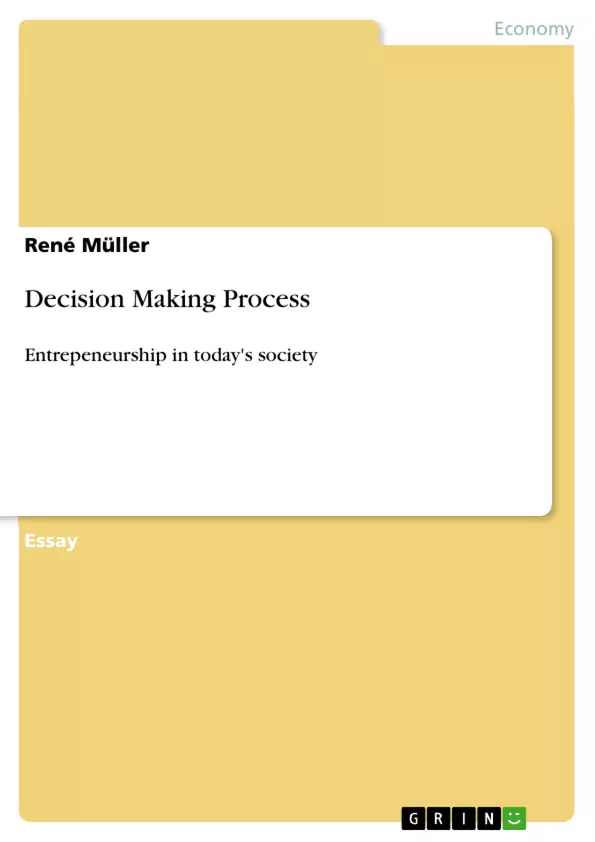The text at hand was written as two assignments for a summer school course at the University of Lincoln in 2010.
The first text is about entrepreneurship. It was written for the course of Kevin Blanchard in the first week of the summer school. It tries to show the importance of entrepreneurs in today’s society.
The second text is about decision making for the second week of the summer school. This course was taught by Steven Marshall. The text tries to show with an example how decision trees work and if they could be applied in more than business decision making.
Inhaltsverzeichnis (Table of Contents)
- Preface
- Entrepreneurship in today's society
- Introduction
- Why is entrepreneurship relevant for today's society?
- Entrepreneurship creates values for society
- Entrepreneurship sets paragons for society
- Conclusion
- Decision Making Process
- What is a Decision Tree?
- My Decision Tree
- Reflexion
Zielsetzung und Themenschwerpunkte (Objectives and Key Themes)
This text aims to explore the significance of entrepreneurship in contemporary society, examining the defining characteristics of an entrepreneur and distinguishing them from innovators. It also delves into the process of decision making, utilizing the example of decision trees to demonstrate their application beyond the realm of business.
- Defining characteristics of an entrepreneur
- The role of entrepreneurship in societal value creation
- The importance of entrepreneurs as role models
- Understanding the decision-making process
- Applications of decision trees in various contexts
Zusammenfassung der Kapitel (Chapter Summaries)
- Preface: This section introduces the two texts, explaining that they were written as assignments for a summer school course at the University of Lincoln in 2010. The first text focuses on entrepreneurship, highlighting its importance in today's society, while the second text explores decision making and its application through decision trees.
- Introduction: The introduction delves into the characteristics of an entrepreneur and discusses the relevance of entrepreneurship in today's society. It examines the key abilities entrepreneurs possess, including the ability to spot opportunities, be creative, manage risks, and be driven by rewards. The introduction also distinguishes entrepreneurs from innovators.
- Why is entrepreneurship relevant for today's society?: This section explores the various ways in which entrepreneurship benefits society. It emphasizes the creation of value through innovation, job creation, and economic growth.
- Entrepreneurship creates values for society: This section delves deeper into the value creation aspect of entrepreneurship. It discusses how entrepreneurs contribute to societal progress by developing innovative products and services that meet evolving needs and improve quality of life.
- Entrepreneurship sets paragons for society: This section explores the role of entrepreneurs as role models. It highlights how successful entrepreneurs inspire others to take risks, pursue their dreams, and contribute to societal advancement through their creativity and hard work.
- Decision Making Process: This section introduces the concept of decision trees as a tool for making informed decisions. It outlines the steps involved in constructing and utilizing decision trees for various scenarios.
- What is a Decision Tree?: This section provides a detailed explanation of decision trees, outlining their components and how they can be used to analyze different options and their potential outcomes.
- My Decision Tree: This section presents a specific example of a decision tree, illustrating its application in a real-world context. It demonstrates how the decision tree can be used to weigh different choices and arrive at a well-informed decision.
- Reflexion: This section reflects on the use of decision trees and their potential applications beyond business decision-making. It discusses the benefits of using decision trees as a structured approach to problem-solving and decision-making.
Schlüsselwörter (Keywords)
The main keywords and focus topics of the text include entrepreneurship, innovation, societal value creation, decision-making, decision trees, risk management, and economic growth. The text explores the characteristics and importance of entrepreneurs in today's society, examines the process of decision making, and utilizes decision trees as an illustrative example of a structured approach to problem-solving.
- Quote paper
- René Müller (Author), 2010, Decision Making Process, Munich, GRIN Verlag, https://www.grin.com/document/157833



